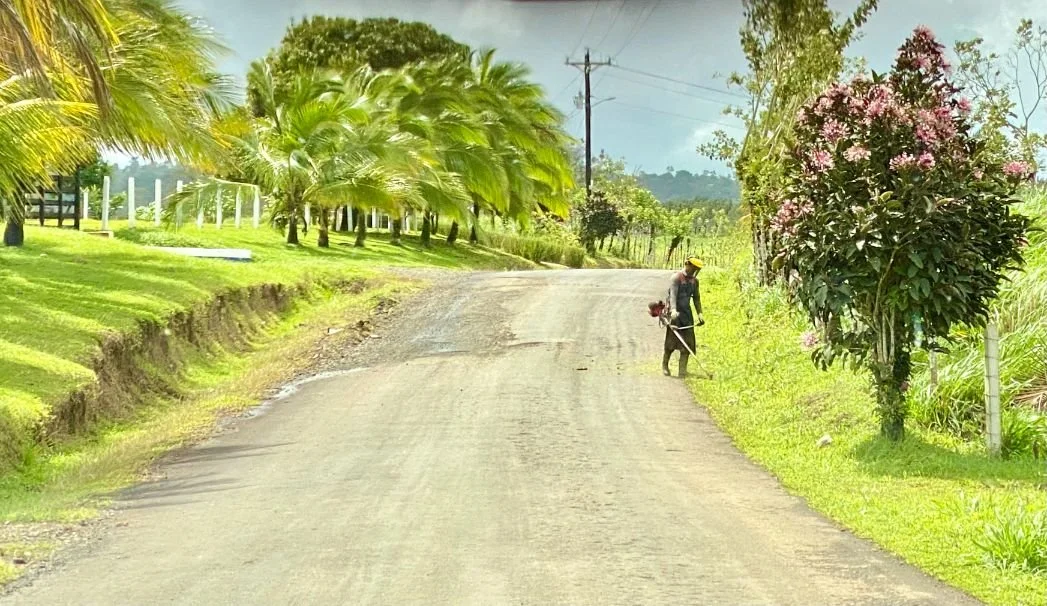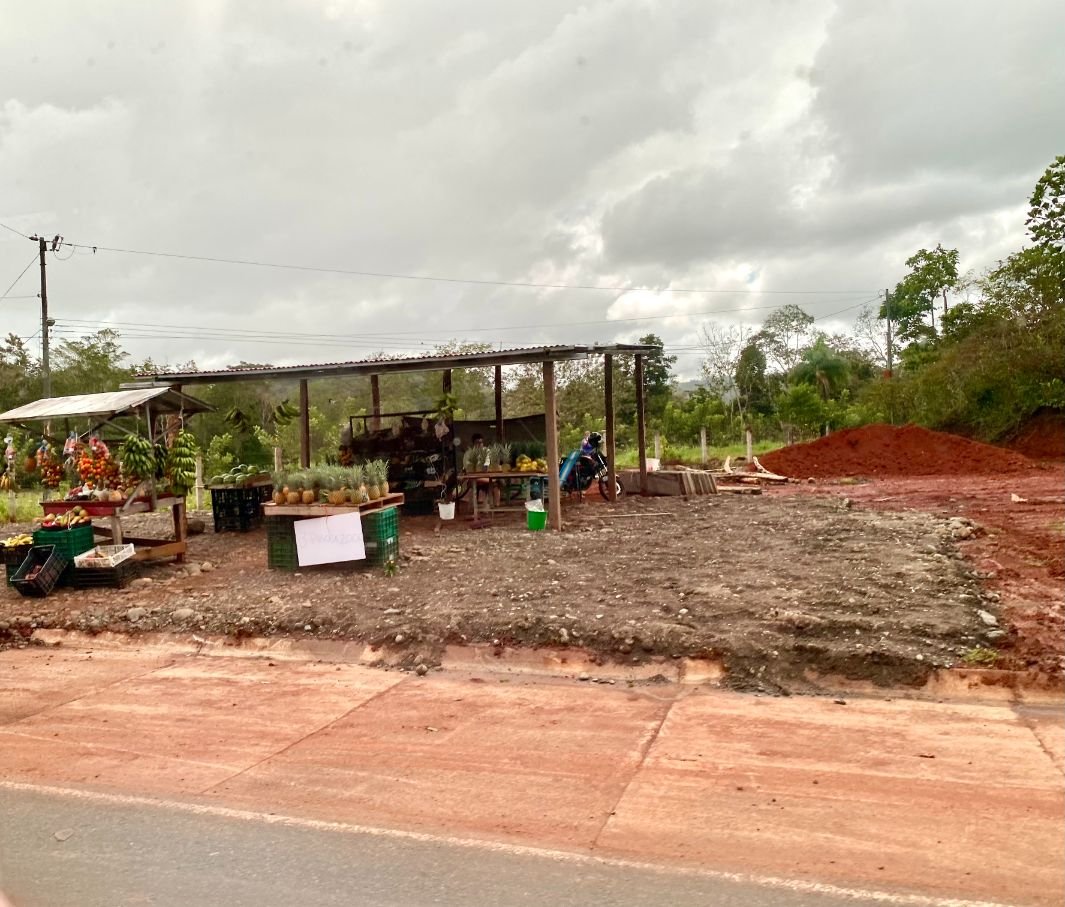Leaving the Juanilama community behind we bump along pretty roads and through beautiful countryside on our way to Rio Celeste and the Tenorio Volcano Park. The earlier rain has lifted into a day of cloudy sunshine, and all around us is glorious green; rolling hills, emerald fields, luscious grass, thousands of trees and the bounty of nature in all directions. It’s like a truly tropical slice of Devon.
After a couple of hours we arrive at Rancho Tojijifuro, which is home to the remaining members of the indigenous Maleku tribe. We’re led straight through a little garden to a dining hut where we’re fed a simple lunch of rice and beans, with a whiteboard on the wall giving us a few words in the Maleku language. Once we’re finished eating we move onto the tribal hut, a large smoky space with rudimentary benches and carvings, masks and artworks hanging on all the walls. Holding court at its centre is Juaquima, leader of the Maleku.
He tells us of the tribe’s history and their current predicament. Of the twenty-four original indigenous tribes of Costa Rica, only four are still in existence and keeping their traditions alive. However the Maleku face the gravest threat to their future as they are now the smallest tribe in the whole of the Americas with less than 650 members left, and 80% of their land destroyed by loggers or illegally taken by the government. As a result of their dwindling numbers they now also face the problem of interbreeding as the remaining few families are all related and so either they start having children outside the tribe, diluting their genes, or they will become riven by deformity and ultimately extinction.
Juaquima is passionate and eloquent, fiery in his anger yet realistic about the Maleku’s ultimate fate. He won’t go down without a fight though and is determined to share the beliefs and traditions of his people with the outside world, beating out a rhythm on his drum made of balsa wood and iguana skin and shaking his giant, illustrated rain stick.
He asks where we are travelling to when we leave this space and on hearing it is Rio Celeste, their ancestral home now denied to them by the government, Juaquima tells us a story about how the blue butterflies we will see there are sacred to the Maleku as, when they flock together down the river, their azul fluttering represents the sparkling waters becoming sky blue and divine.
The beauty of the Maleku’s relationship with nature is celebrated in their artwork and they make their living as artisans. We buy a painted jaguar mask, featuring a toucan and the sacred butterflies to hang on our wall at home. A shy lady called Carmen reveals that she was the one who painted it, and then leads us all through an art class using the hard shells of the jicara fruit as our canvas, onto which we paint our own designs of Costa Rica’s wildlife.
Outside the tribal hut hummingbirds and butterflies take flight but the Maleku’s cat is no respecter of their beauty and grabs a hummingbird out of the air, running off with it clutched firmly in its mouth. A metaphor perhaps of how the innocent existence of the Maleku is being extinguished by forces greater than them.
We say our goodbyes and continue on our way, arriving into the town of Guatuso as both evening and rain falls upon us. Our resting place for the next two nights is a very basic motel called Cabinas Suena Real which has an even more basic restaurant attached to it where we all gather for dinner. The only vegetarian dish they can provide is overcooked spaghetti with undercooked vegetables in what appears to be a can of tomato soup. It takes the prize for the worst meal we have eaten on this entire two-month journey and we retire to bed tired and a little frustrated.
The next morning our mood is not lifted when we are greeted by overcast grey skies and heavy rain. We are due to be hiking in Tenorio Volcano Park today, and seeing its famous blue waters, but even with our waterproofs and hiking boots it’s going to be a soggy affair. The minibus Jonathan has arranged for us can’t fit everyone in so Coman and myself are joined by Helen and Alex, proud northerners and fellow pidgin Spanish-speakers, in a separate vehicle driven by Julio who speaks no English.
I’m designated to sit up front with him and as we drive through the rain he tells me he only works with tourists at the weekends. His main job is in the police as a narcotics enforcement officer on the nearby border with Nicaragua, working with dogs to seize marijuana, cocaine and heroin. I reassure him we’re all squeaky clean!
Once inside the national park we hike along an increasingly difficult route, fording streams and climbing boulders, slipping in mud and crossing hanging bridges, while Tenorio volcano is obscured by clouds. The park, which is credited at its entrance as the ancestral homeland of the Maleku despite them now being forbidden to live there, is home to an impressive array of nature with 540 bird species, 72 mammal species, 27 different amphibian and 52 reptile species, and close to 4000 plant species living within what has been designated by UNESCO as the Agua y Paz Biosphere Reserve.
We’re here to visit its thundering turquoise waterfall, which requires descending and ascending hundreds of steps, the sulphuric springs called ‘borbollones’ and blue lagoon all of which impress despite the ever-changing weather. And as we stand at the Laguna Azul the sun comes out making the waters even richer in their mineral blue hue, similar to that of the morpho butterflies. The Maleku believe that when God was painting the sky he used this pool to dip his paintbrushes, hence the colour of the water. It’s rather a lovely thought.
Despite the challenging weather the hike is very enjoyable and we leave Tenorio park drenched but happy, to drive for an hour through more gorgeous countryside.
We stop at El Árbol de La Paz, a giant 500 year old tree that stretches high into the sky, and again at a little lake where a caiman has been spotted lazing on a log facing six turtles, all soaking up the sunshine which has broken through.
Our next destination is a much needed restaurant where Coman and I make up for last night’s desultory pasta by consuming a much-needed and ridiculously enormous pizza, before we all get to swim in the refreshing waters of Poza Los Congos, the Pond of the Howler Monkeys, whilst clinging to branches to battle the currents. As we splash around a cowboy appears and drives his horses straight through the water beside us,
As afternoon turns to evening Mark, Coman and I walk up the road from our dreary motel, past the bridge over the Rio Frío, to the centre of Guatuso, with its church, supermarket, bizarre Maleku sculpture and little square, chatting to a few friendly locals, and having a drink in its solitary bar, Jimmys, which also serves as a restaurant, inexplicably serving Chinese food. The Saturday night crowd is in, having food with their children whilst racy Latino music videos pump out, but we head back to our lodgings to prepare for tomorrow’s new adventure.
We are off to the hot springs and giant volcano of La Fortuna, unaware that our medical kit which has lain un-needed in the deepest recesses of our rucksack, is about to prove very useful indeed.




























































